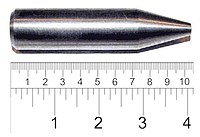
Photo from wikipedia
Abstract Nanosafety assessment has experienced an intense era of research during the past decades driven by a vivid interest of regulators, industry, and society. Toxicological assays based on in vitro… Click to show full abstract
Abstract Nanosafety assessment has experienced an intense era of research during the past decades driven by a vivid interest of regulators, industry, and society. Toxicological assays based on in vitro cellular models have undergone an evolution from experimentation using nanoparticulate systems on singular epithelial cell models to employing advanced complex models more realistically mimicking the respective body barriers for analyzing their capacity to alter the immune state of exposed individuals. During this phase, a number of lessons were learned. We have thus arrived at a state where the next chapters have to be opened, pursuing the following objectives: (1) to elucidate underlying mechanisms, (2) to address effects on vulnerable groups, (3) to test material mixtures, and (4) to use realistic doses on (5) sophisticated models. Moreover, data reproducibility has become a significant demand. In this context, we studied the emerging concept of adverse outcome pathways (AOPs) from the perspective of immune activation and modulation resulting in pro‐inflammatory versus tolerogenic responses. When considering the interaction of nanomaterials with biological systems, protein corona formation represents the relevant molecular initiating event (e.g., by potential alterations of nanomaterial‐adsorbed proteins). Using this as an example, we illustrate how integrated experimental–computational workflows combining in vitro assays with in silico models aid in data enrichment and upon comprehensive ontology‐annotated (meta)data upload to online repositories assure FAIRness (Findability, Accessibility, Interoperability, Reusability). Such digital twinning may, in future, assist in early‐stage decision‐making during therapeutic development, and hence, promote safe‐by‐design innovation in nanomedicine. Moreover, it may, in combination with in silico‐based exposure‐relevant dose‐finding, serve for risk monitoring in particularly loaded areas, for example, workplaces, taking into account pre‐existing health conditions. This article is categorized under: Toxicology and Regulatory Issues in Nanomedicine > Toxicology of Nanomaterials
Journal Title: Wiley Interdisciplinary Reviews. Nanomedicine and Nanobiotechnology
Year Published: 2022
Link to full text (if available)
Share on Social Media: Sign Up to like & get
recommendations!